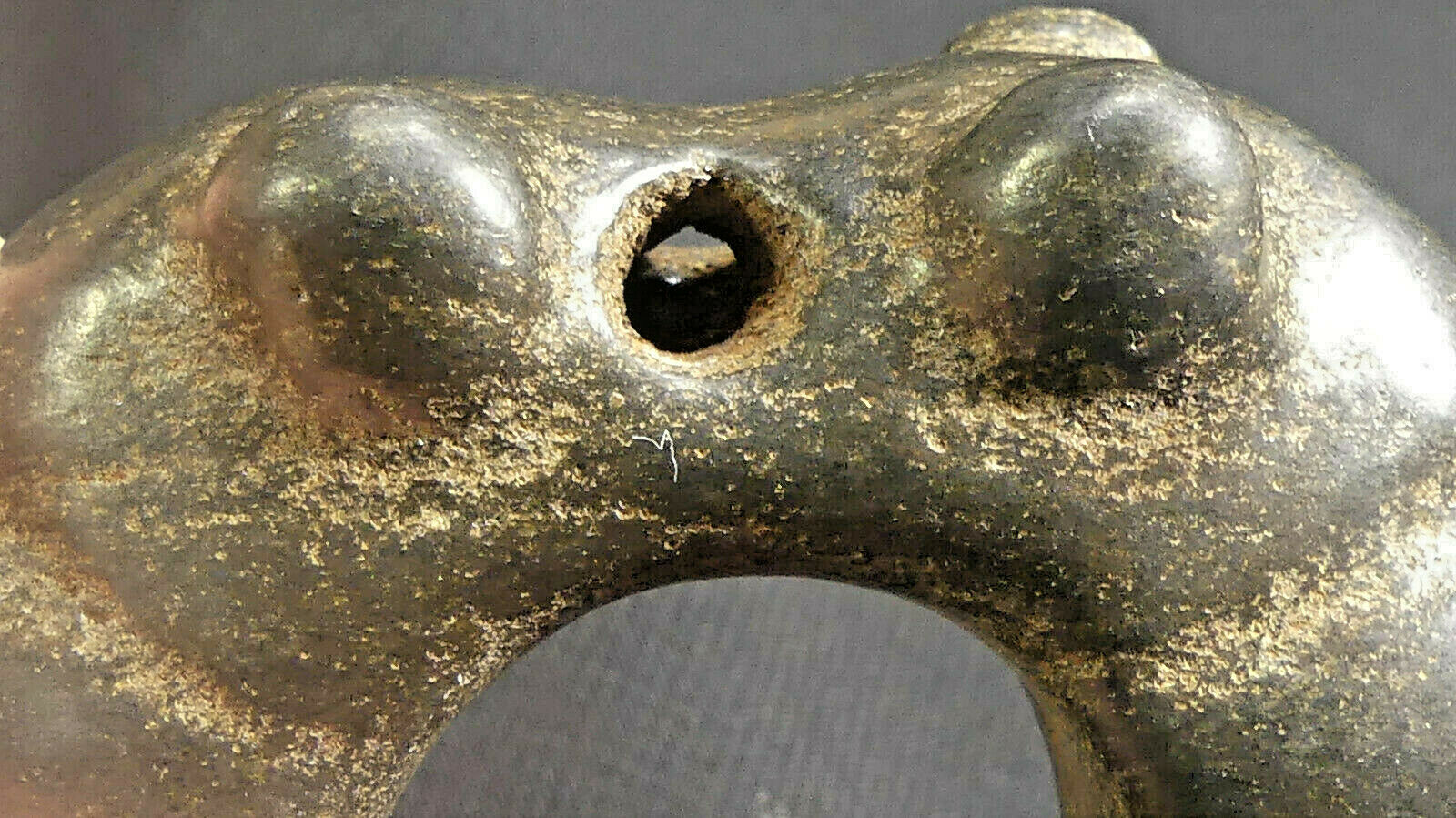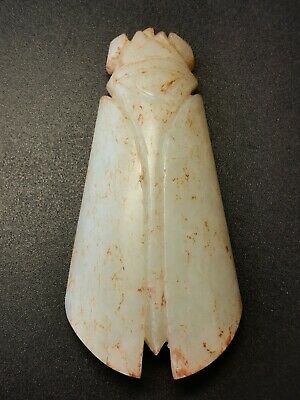-40%
China Hongshan Black Jade Immortality 2 Joined Cicadas Amulet w/1140+ Characters
$ 5860.8
- Description
- Size Guide
Description
ANCIENT CIVILIZATIONSArtifacts, Antiques & Fine Collectibles
Chinese Hongshan Culture Black Jade Disk (Yuan) Amulet
Two Joined Cicadas {Chan (蝉) in Mandarin}
An Estimated 1,140 Early Pictographic Characters!
A Son and Grandson’s Ritual Offering
c. 4500 BC—2250 BC
A gentleman always carried a jade pendant, as a symbol of class and
to remind him the virtues of a gentleman,
since those virtues were found in jade.
—Confucius
Summary
This unique, Black Jade Double Cicada Amulet measures approximately 2.23” (57 mm) in outside diameter x .83” (21 mm) inside diameter, and weighs 4.1 oz. (117 gr.) of highly prized Black Jade. This type of jade was thought to possess magical powers that would ensure immortality in Heaven.
These two jade cicadas are joined and depicted in the larva stage. They are joined at the head and tail to form a perfect circle. In ancient China, Heaven (Tien in Chinese) was represented by a circle, while a square shape represented the Earth.
What makes this Cicada Amulet unique is that it has an estimated 1,140 pictographic characters engraved and pecked into the cut lines and on the inside the circular amulet. This long of an offering/dedication on a single piece of jade is unique in Hongshan culture.
There are no recorded artifacts that have been discovered from the Hongshan Culture (4,500 BC—2,250 BC) that have this many characters—not in private collections or even in the world’s finest museums. This is truly a piece for the advanced private collector or museum.
This jade offering appears to be from the son and grandsons of the deceased and was certainly a ritual offering to the Ancestors in Heaven to grant the deceased immortality. This amulet offering had to be crafted and engraved for a wealthy upper class or royal person, as only those individuals would have the means to afford such an expensive and elaborate offering. More details below.
Condition: This amulet is in exceptionally good, museum quality condition, with no repairs or restorations. It has been professionally cleaned by the previous owners that allows us to better see the character inscription/dedication. But it still retains its lovely, original patina of mineral deposits (especially iron and calcium) and of micro-crystalline jade white crystals.
This jade amulet has two, small, curved holes between the heads of two cicadas that would have been used for suspension around the neck. These holes are called “Ox-Nose Holes” and have been drilled by ancient hand tools at low RPM from both sides of the amulet--see macro photos. These are period correct and have a wonderful layer of calcium and micro-crystalline jade inside the bore holes—just perfect. {see photo # 8}
Details
Jade was highly prized by these early civilizations in China and it was thought to have positive energy to drive away evil spirits and bring good luck and fortune to all who wore a piece on their person--in life and in death. Jade was also believed to be a portal or messenger that could carry prayers to Heaven and send messages to those on Earth from departed ancestors and Gods in Heaven.
Cicadas are called chan (蝉) in Mandarin Chinese. But they are also referred to as guo guo (蟈蟈), which generally refers to a cricket. In ancient China, the cicada was a symbol of transformation and resurrection because of its life cycle. The first 13 to 17 years of its life are spent underground, after which, it emerges in its final nymph stage. It then sheds its skin to reveal a mature form with wings. These cojoined cicadas were a symbol of this resurrection. Perhaps they represent the resurrection of the son and his father as they enjoy immortality in Heaven.
By placing these pieces in the mouth or near the body, they believed that they would confer the properties and virtues of permanence and purity to the deceased and transform one to a deathless, jade-like state; immortals were often described as having a jade-like appearance. In attaining this deathless state, one could avoid the bureaucracy of the underworld and be ensured eternal existence in Heaven with one’s ancestors. Used together, the plugs would preserve the vital energies so that the body could later be resurrected; the cicada was a symbol of this resurrection.
English Translation of the Offering
As noted above, this unique amulet contains an estimated 1,140 tiny, ancient, Chinese pictographic characters that have been pecked and engraved on the amulet. The characters were normally written to offer sacrifice to the Ancestors and plead that they accept the soul of the departed into Heaven (Tien) for eternal life.
We know that this amulet was made in the mid-Hongshan Culture (4700 BC—2250 BC) because of the characters on this amulet, as this Neolithic culture used this type of character/word (also called graphics) from 3,800 BC until about 3,000 BC. This style of writing called Shuowen Jiezi was used before the next type of Chinese characters were used to form a written language that we now call Seal Script or Ku’wen. {Ref: Chinese Characters, Wieger, S.J., pg. 366.
This remarkable black jade cicada amulet disk has an estimated 1,140 very small characters/graphics on both the outside and on the inside edge of the amulet (see photos) that depicts the son with his arms raised as he is being raptured and transported mentally in the presence of his Ancestors, by his filial love for his father and desire to please his Ancestors and accept his father into Heaven and grant him immortality.
In each of the 18 cut lines on both side of cicada amulet, there are an estimate 60 characters in each cut line that appears white do to the microcrystalline jade that has formed after millennia of exposure to minerals in the damp soil. Therefore, 18 cut lines x 60 characters = 1,080 characters on the surface of these two cicadas! And there are perhaps another 60 or so characters on the inside of the circle made by the two cicadas, for an estimated 1,140 characters! And some even on the shoulders of the small suspension holes drilled between the two cicada’s heads.
This long of a dedication on a single piece of jade is unique in Hongshan culture. There are no recorded artifacts that have been discovered in the history of the Hongshan that have this many characters—not in private collections or even in the world’s finest museums.
These amazing graphics can best be seen with 50+ magnification on both the outer and inner circle of this amulet, but even then I cannot see them clearly enough to decipher all of them. Millenia of mineral deposits and natural weather have made it difficult for me to clearly see the tiny figures—some only about .5—1 mm tall, the largest is only 2 mm tall. This artwork is truly spectacular and of museum quality. Here are just a few of the characters that are engraved in the ancient pictographic script over 5,000-years-ago:
· The son offering ritual items to the father
· Grandsons offering ritual items
· The smell of meat being offered to the Ancestors
· The character that looks like the letter “T” and means superior or highest in Chinese. This symbol is used to honor the Ancestors and Gods in Heaven (in Chinese Tien).
· Two parallel lines is the character “Erh” that means “two” and is the number of the Earth because it makes the pair with Heaven.
· Ritual wine being offered
· Jade being offered
· Money (cowries) being offered
· Speeches honoring the departed
· “San” Heaven, Earth & Mankind
· An offering of bronze
· The underground tomb of the departed
· Ancestors
· Dragons
· Lions
· Rams
· And more than 1,100 other characters!
In ancient times, inscriptions and dedications to honor the deceased were oftentimes inscribed in places that only the Ancestors and Gods could see, or made so small that only the Ancestors could read them. It was believed that mere mortals were not worthy to read inscriptions meant only for the eyes of departed Ancestors in Heaven (Tien).
The Hongshan Culture
The Hongshan were temple builders and city builders who created some of the earliest nephrite jade carvings. Their sophisticated Jade carving techniques employed technologies that exceeded simple explanations. It has recently been discovered that the Hongshan possessed the knowledge of metallurgy and employed the use of copper and iron from meteorites as tools to work their jade masterpieces. Many of the Hongshan Jade artifacts are well persevered because the Hongshan culture utilized slab burial tombs and because of the dry arid climate of Inner Mongolia.
As many of you know, Nephrite jade, also known as “soft jade” or “ancient Jade” in China, was used from China’s early Neolithic cultures in 8,000 BC to 1800 AD for carving all types of ritual and utilitarian items. Nephrite, which is somewhat “softer” than the jadeite used by Neolithic Japanese and European cultures, was easier to cut, carve, polish, and drill than jadeite. So, the ancient Chinese found that Nephrite Jade could be worked by using quartz or garnet sand, polished with bamboo or jade dust, and even drilled with wood drills that used a slurry made of jade dust and water as the abrasive.
Based on artifact evidence and 30 years of study, it appears that the Hongshan employed advanced jade shaping and carving tools that may have been made from meteorite iron or even diamonds. One fascinating study is the evidence of high content iron found in black jades used for ritual objects by the early Hongshan. Many of these artifacts are often magnetic and express the possibility that the Hongshan were aware of magnetic earth forces.
During China’s Neolithic Period, Hongshan Jade ritual and tomb objects were created for a period of more than 2,000 years. Hongshan jades have been discovered in large quantities with over 52 different types of Jade objects in various shapes and forms.
Value
I have carefully examined this ancient jade amulet and I GUARANTEE it to be original and authentic or your money back! I’ve looked under 10x and 50x magnification under both natural and Black Light and I can find no signs of any modern tool work or repairs. The hand tool marks left in the jade by the master stone artist who carved, shaped, and engraved this work of art appear to be consistent with those marks of other ancient jades I have examined.
Each object I sell is professionally researched, translated (if I can...(smile), and compared with similar objects in the collections of the finest museums in the world. I have been dealing in fine antiquities for over 45 years and although certainly not an expert in every field, I have been honored to appraise, buy, collect, and enjoy and recently sell some of the finest ancient art in the world. When in doubt, I have worked with dozens of subject matter experts to determine the condition and authenticity of numerous antiquities and antiques. This careful examination helps to insure you are buying quality items and helps to protect your investment. There are many modern reproductions or "fakes" on the market today, so be sure and buy only from experts in the field.
Please examine the macro photos taken indoors carefully, as they are part of the description.
The stand is not part of the auction, just included to give you a better perspective.
And please ask any questions before you buy.
I GUARANTEE this amulet is ancient and authentic or your money back!
Per e-Bay's rules, PayPal only please!
THANKS!
FREE SHIPPING IN USA includes INSURANCE for all 50 United States.
Overseas buyers are responsible for all import & excises taxes, duties, and shipping charges.















